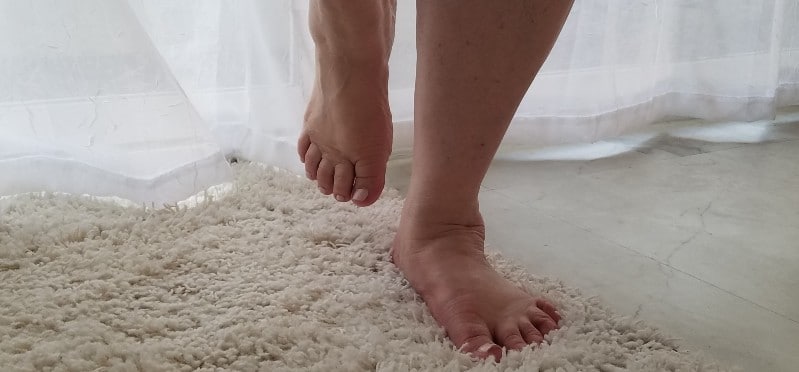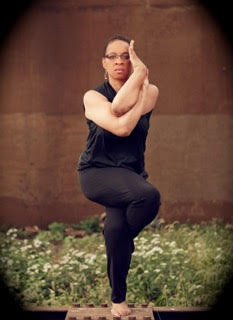Better Balance Makes A Stronger Triathlete

Does better balance make for a stronger triathlete? I believe it does.
In the post titled “Triathlon Bike Training When You Can’t Ride Outside” published last month, I wrote about my upcoming skate skiing lesson. Why skate skiing? Because it is great cross-training for the bike leg of triathlon.
I completed the lesson, finishing with a game plan from the instructor for further developing my skate skiing technique. Before the second, solo outing with the skate skis, I watched a few videos with drills for beginners.
The videos reinforced what I had learned during the lesson, that skate skiing requires much better balance than classic cross country skiing. Before moving from the practice area to the course, I must learn to balance while gliding on one ski longer than I am currently able.
How do I improve my balance? That is the question I have been trying to answer and the subject of this post.
What is Balance?
According to the non-profit VeDA, “Balance is achieved and maintained by a complex set of sensorimotor control systems that include sensory input from vision (sight), proprioception (touch), and the vestibular system (motion, equilibrium, spatial orientation); integration of that sensory input; and motor output to the eye and body muscles.”
Essentially, balance involves the following three processes:
- Signals from inputs (eyes, ears, touch, etc.) travel to and are processed by the brain.
- Signals from the brain travel to the muscles required to maintain balance.
- These muscles contract as needed to stabilize the body.
For good balance, these processes must occur quickly and efficiently.

How Does Age Affect Balance?
Balance tends to decline with age, beginning as early as age 40. According to the USA’s National Institutes of Health, a problem with balance is among the most common reasons older adults seek help from a doctor.
Poor balance can have many causes. These include disease, loss of eyesight, reaction to medications, changes in the skeletal system, and loss of muscle strength and joint flexibility.
Muscle strength is key to balance for a healthy, active adult. Strong muscles allow the signals from the brain to produce quick response. Conversely, if muscles are weak, they may not be able to provide adequate or fast enough response to maintain balance.
The foot, which can also change with age, is critical to balance. Even a relatively minor change, such as growth of a bunion, has been shown to affect balance.
Posture, which affects one’s center of gravity, often becomes poorer with age through loss of core muscle strength. If our body’s center of gravity is not directly over the support position, we are not balanced. With poor posture, we are less stable and more likely to fall.
How Can Balance Be Improved?
Assuming no other medical conditions, balance is primarily related to the neuromuscular system. Therefore, the current training program can be modified to (1) strengthen any overlooked muscles that affect balance and (2) train the nervous system.
Sensory systems
According to an article on the NESTA (National Exercise & Sports Trainers Association) website, adaptation of the nervous system occurs more quickly than does building of muscle mass. Early in a strength training program, the ability to lift greater weight is due more to adaptation of the nervous system than to increase in muscle mass.
The Law of Facilitation is in play when a signal from the brain to a muscle or set of muscles passes through a given pathway, excluding other paths. As the movement is repeated, the resistance in the ideal path becomes progressively smaller with the number of repetitions. The body continues to adapt and respond more efficiently until the movement becomes automatic.
Through this process of adaptation, we are creating what is often called ‘muscle memory‘. Through practice, even complex movements are made with little or no conscious effort.
Muscle strength
Several posts, including Six Principles of Triathlon Training for Seniors, document that the rate of muscle loss increases with age. Our goal is to reduce the rate of muscle loss. As noted earlier, one component of a program to improve balance is to strengthen the muscles affecting balance.
While the focus of most strength training for triathlon is the larger muscles (gluteus maximus, hamstring, quadriceps), smaller muscles (gluteus medius, soleus) are often ignored and lose strength without us realizing it.
Since these smaller muscles are important for stabilizing the hip and knee when standing on one leg, they are important for balance and, therefore, skate skiing and ice skating as well as biking and running.
Posture
My wife is a stickler for good posture. After many years of ignoring her comments about my posture, I now encourage her to point out when I am slouching or not sitting tall. She relishes the assignment and is quite good at it.
Exercises To Develop Better Balance and Become a Stronger Triathlete
Through a ski instructor, physical therapist, and several websites, I have developed a routine that I expect will lead to better balance for skate skiing.
The following series of exercises is performed three days per week. They are add-ons to regular strength training, which includes a series of five core strengthening exercises and a new exercise targeting the gluteus medius.
Single leg balance
Skitrax has produced a video demonstrating three ‘dry land’ drills for improving balance. The video shows these drills; I have added the duration for each set.
- Single leg stand – stand on one leg with the knee bent slightly and the other leg off the ground and stationary. Hold for one minute on each leg. Once this becomes too easy with your eyes fixed on a point in the distance, try it with your eyes open but looking to your right or left. Then try it with your eyes closed.
- Single leg swing – stand on one leg with the knee bent slightly and the other leg swinging forward and backward. Move your arms in combination with your leg. Repeat one minute on each leg.
- Single leg dip – stand on one leg with the other out to the side, then bend the knee of the leg on which you are balancing to dip down and return to standing upright with your knee bent slightly. Repeat for one minute on each leg for 10-15 repetitions.
- Single leg hop scotch – hop on one leg, landing inside an array of five real or imaginary rings and return backward to the start. Switch legs and repeat. Maintain standing balance at the end of each repetition.
Expect these to become easier as your body adapts to the position and the stabilizing muscles become stronger.
Single leg forward jump and hold
To even more closely mimic the movements in skate skiing than those of the single leg hop scotch, Peter from McBike & Sport suggests hopping forward and out onto one foot and holding this position for one to two seconds to simulate maintaining balance during the glide. Repeat the sequence on the other foot for one repetition. I am working up to repeating this 50 times for each foot.
Check-out the video demonstration of this drill.
Better Balance Makes A Stronger, Less Injury Prone Runner
This project started out as an effort to find a better, more enjoyable way of training for the bike leg during the winter without sitting on a trainer or moving to a warmer climate or buying a fat tire bike.
What I have learned is that better balance will also help in the run leg. Running is effectively a matter of jumping onto one leg and balancing on it for a short time then repeating this on the other leg. Good balance of each leg minimizes fatigue and injury from running.
Essentially, running is a series of single leg squat jumps, occurring quickly and repetitively.
The Importance of Single Leg Balance
What’s Next?
Over the next several weeks, I will be working to improve balance so that I can get back out on the snow with better skate skiing form. I will keep you posted on what I learn.
Meanwhile, please share your thoughts on the exercises I have added to my routine.
Also, I would love to hear what you have done or are currently doing to maintain or improve your balance.
Share your comments below.
